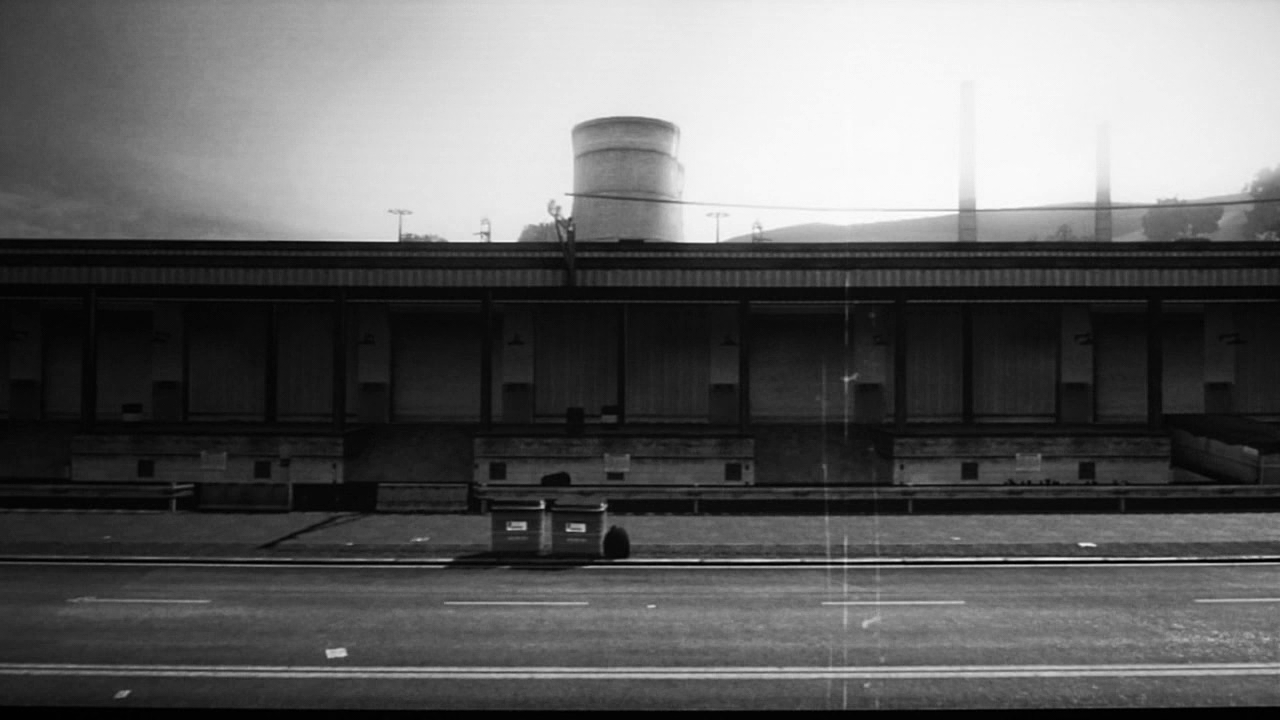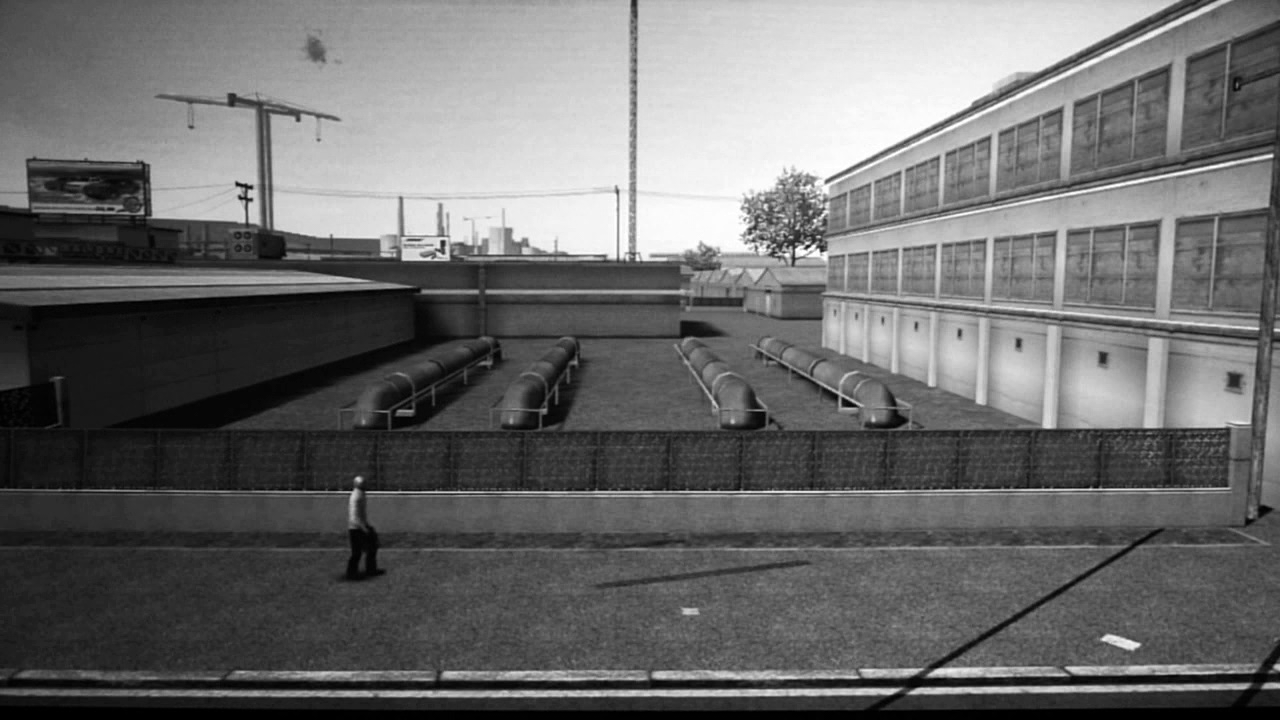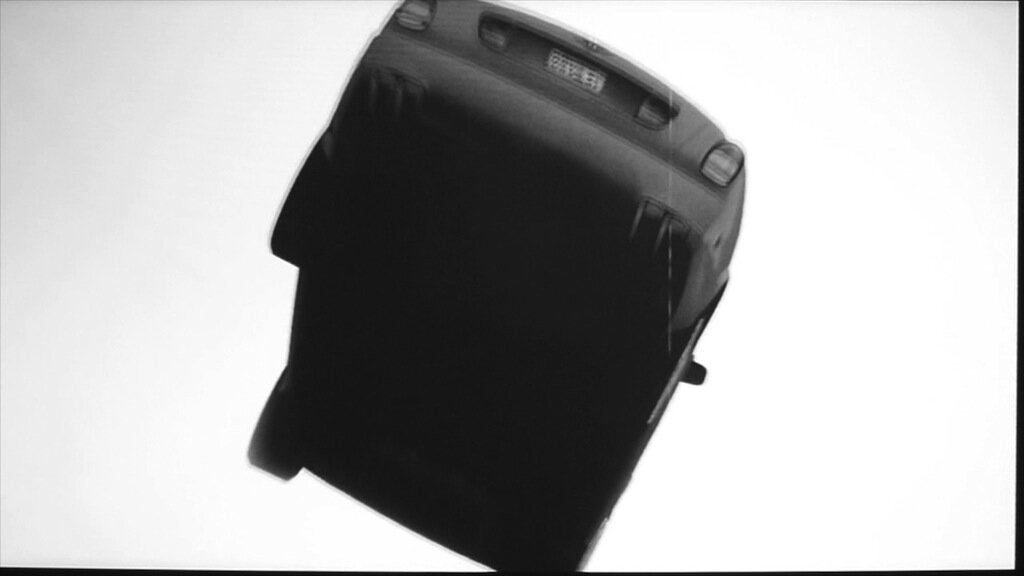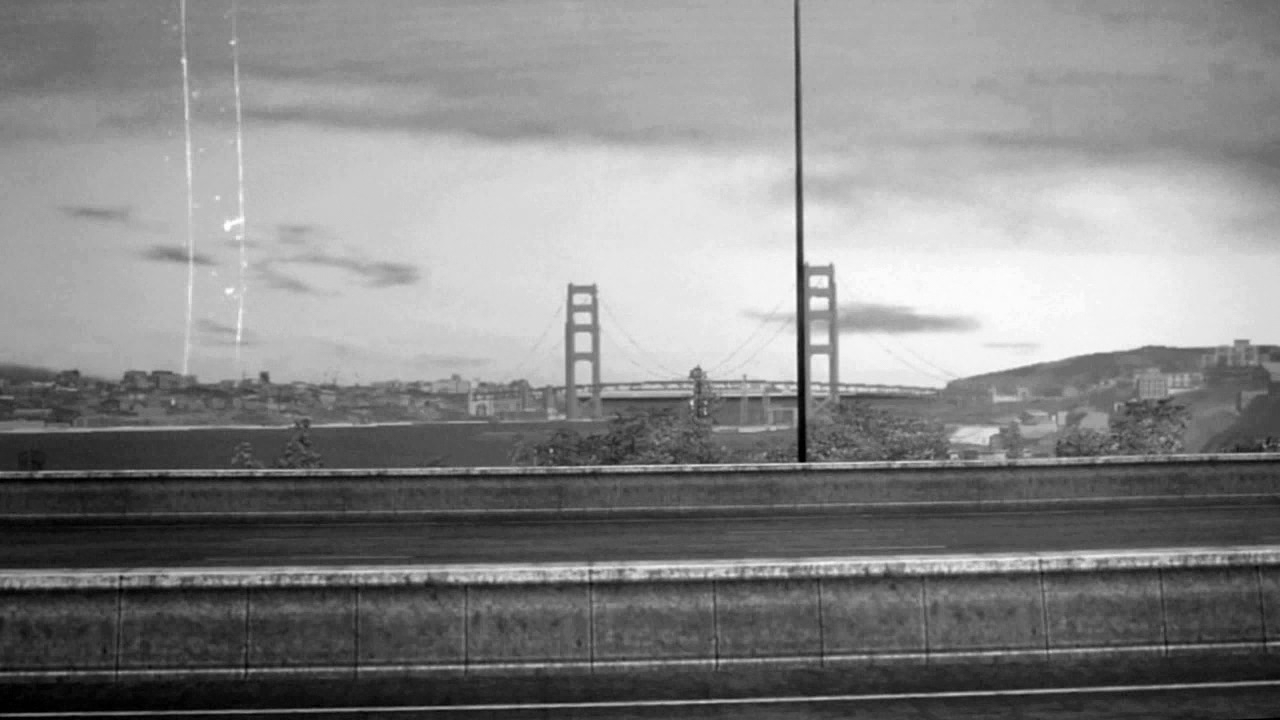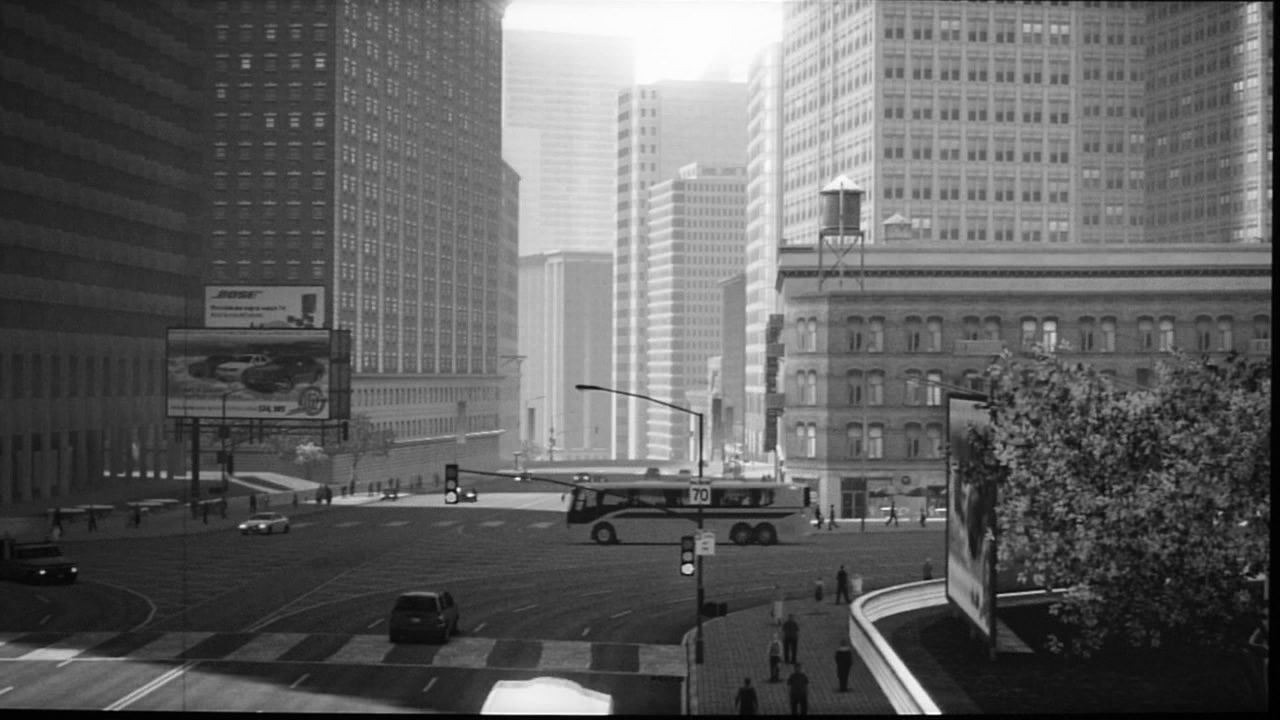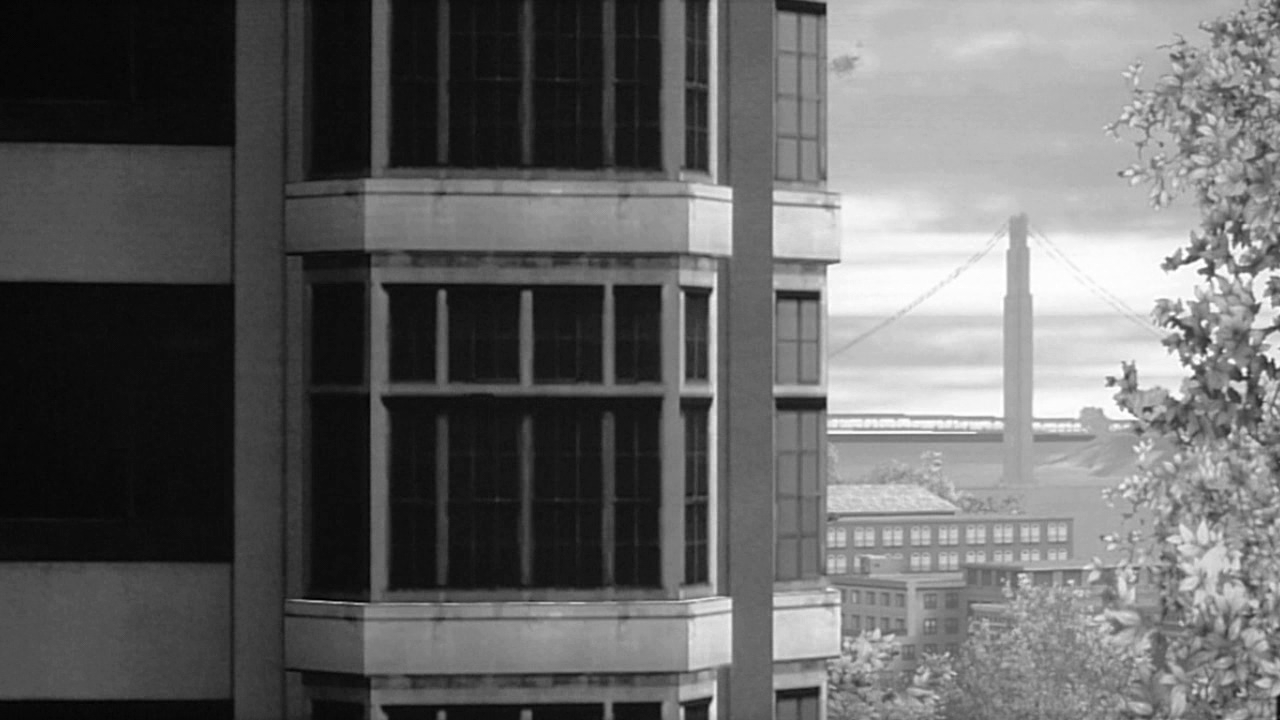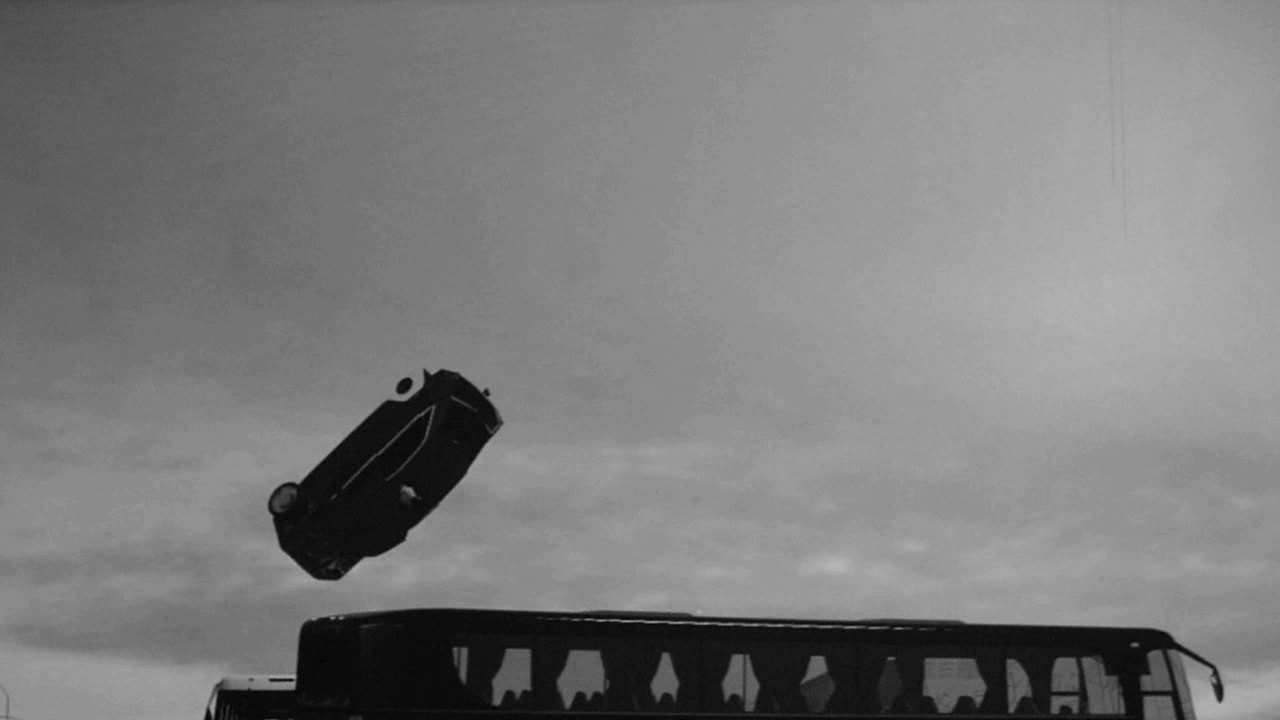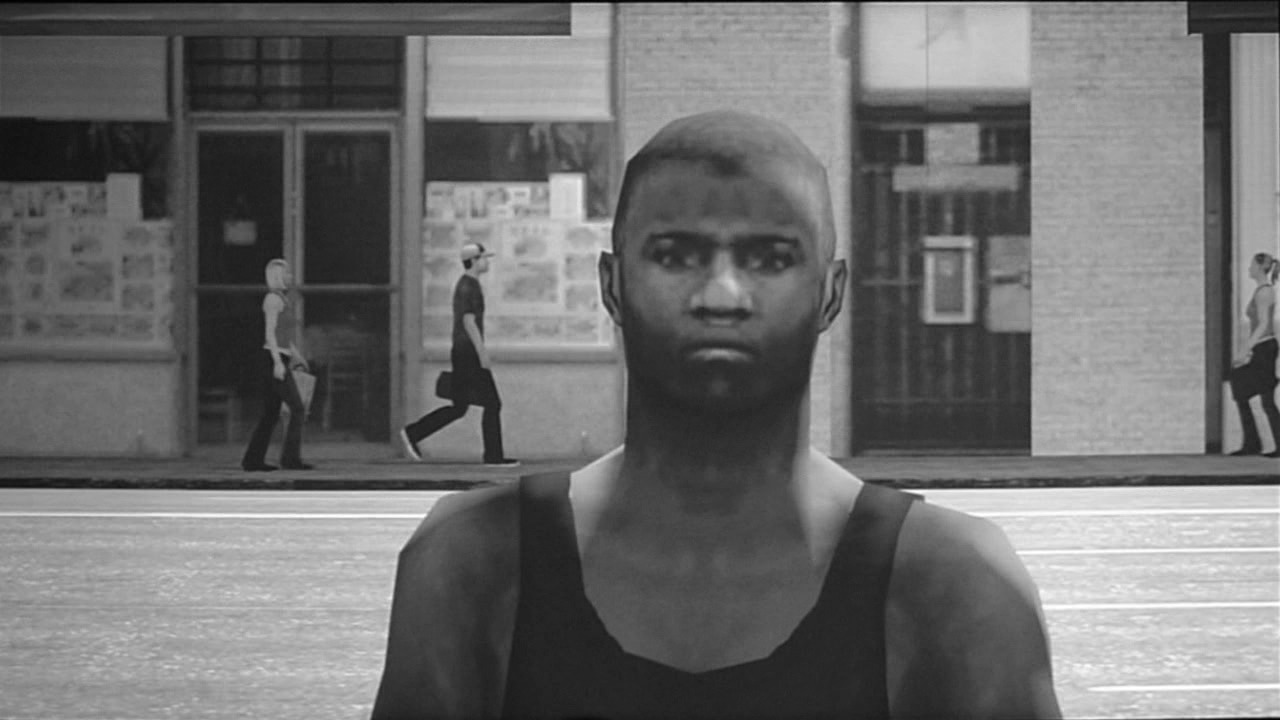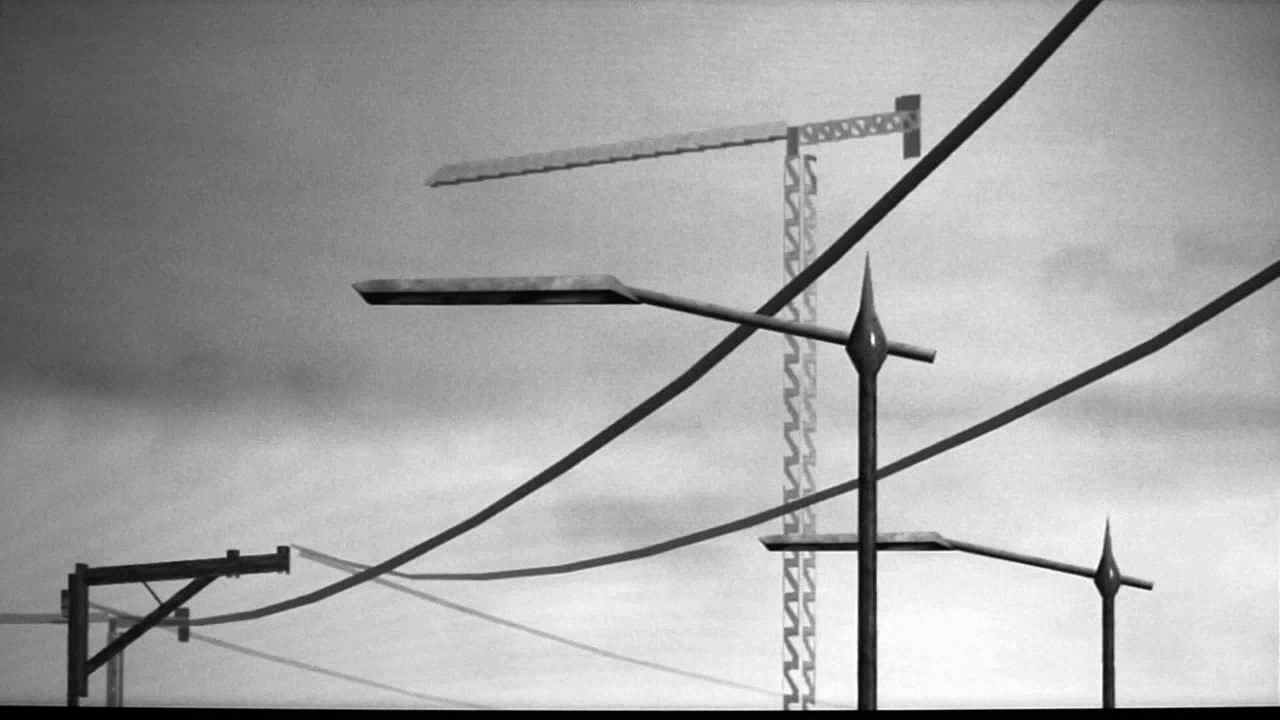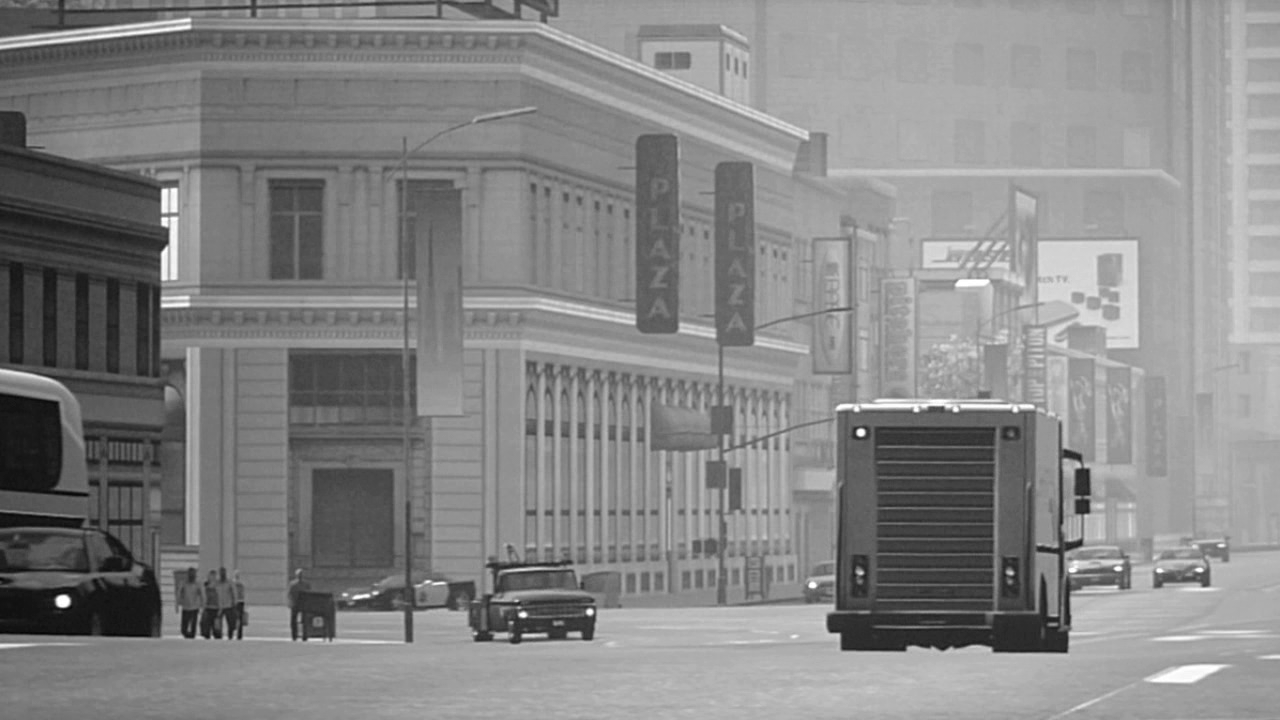Is It Real Love? Of Course Not!
digital video (1280 x 720), black and white, sound, 23’ 02”, 2012-2013, Austria
Created by Florian Hofnar Krepčik
Is it real love? Of course not! is a unique film entirely shot with/in Driver: San Francisco, a 2011 video game by Ubisoft set in the Bay Area. Organized around seven musical themes imbued with philosophical references and poetic gravitas, this hybrid movie is a distillation of magical moments. By layering images, sounds, and spoken words, the artist creates an unforgettable audio-visual experience. The “story” takes place in the chasm between spaces and characters: massive buildings, multi-lane roads, spectacular bridges, and anonymous pedestrians. Presented at several international festivals and exhibitions — including MU Hybrid Art House (2013), TENT Rotterdam, the Hamburg International Short Film Festival (2014), and HMKV, Dortmund Germany (2014) — Is it love? Of course not! was also selected for the Best of Graduates 2013 exhibition at Ron Mandos gallery in Rotterdam, The Netherlands.
A self-described film composer, Vienna-born artist Florian Hofnar Krepčik draws inspiration from opera, music, film, and theatre. After graduating in 2013 from St. Joost, Den Bosch in the Netherlands, Krepčik created a series of films informed by the logic of music and poetry, including Two Monasteries (2015). His audiovisual productions often follow the structure of a music composition. His stated intention is to recontextualize the cinematic through different media.
Matteo Bittanti: Can you describe your upbringing? What and where did you study?
Florian Hofnar Krepčik: I was born in Vienna, Austria in 1988. I lived there for the first two decades of my life. I grew up immersed in music, my mother was a music teacher. I was one of the few lucky boys to own a personal computer from an early age. I instantly fell in love with cinema, especially Hollywood movies. To make a long story short, my upbringing was marked by an uninterrupted flow of music and films. At the age of twenty, I moved to The Netherlands to study Fine Arts at St. Joost in Den Bosch. It was a small school in an even smaller city, which had one key advantage: the complete absence of distractions helped me to focus on my artistic practice. I began working with the medium of photography but soon moved to photographic installations. However, I found photography to be too static and I realized that I wanted to work with an aesthetic form that was both time-based and photorealistic. My ultimate goal was to direct the viewer’s experience, like an orchestra conductor.
Matteo Bittanti: I would love to know more about the origins of Is it love? Of course not!. Why did you decide to turn Driver: San Francisco into the set of your film? And what is your relationship to video games beyond this project?
Florian Hofnar Krepčik: Well, my decision to use Driver: San Francisco was purely pragmatic, if you will. First of all, that game featured a cinematic mode that allowed players to take the role of a film director. Every action performed inside the game could be easily recorded: players could later place cameras wherever they wanted to capture the action, simulating the cinematic eye. It was the only game I knew that I could use to achieve impressive results without the need for mods or other tools which were beyond my skill level. The fact that I really liked Driver: San Francisco to begin with was also helpful. I completed that game twice, so I knew my way around the confines of the city but also in the outskirts. I mapped out the entire territory: to me, playing soon became a form of location scouting. I knew which building or street or tree I could use for a specific purpose, well beyond the predefined goals of the competition. The simulated San Francisco was much more than the setting of a video game: I became intimately familiar with its topology. It felt real to me.
In regard to your second question, I have a wonderful relationship with video games. They are a bridge connecting the here to the outhere. Their liminal nature provides plenty of aesthetic pleasure. Video games allowed me to explore the notions of realism, reality and so forth.
Matteo Bittanti: Have you made other films with/in a video game after Is it real love? Of course not!? Based on your experience, what are the main advantages and disadvantages of “filming” within a simulated space?
Florian Hofnar Krepčik: Actually, no. To my big disappointment, I found very few games equipped with a powerful film editor that allows the player/director to control the cameras, detaching their omnipresent view from the main character, and let the action roll, or, better re-roll. For the record, I did create a second video game movie by editing footage of a variety of games, including Assassin’s Creed, Grand Theft Auto, and Forza Motorsport, to compensate for the lack of cinematic compositing. However, as of today, I have not released the movie, because I remain unconvinced by the results. I am very interested in transforming a video game to make it look like cinema, but with that centralised camera angle thing, so to speak, it will always reveal itself as a video game. It’s a bit of a let down. I find it interesting that video game companies have been implementing photo modes for years, but have, for the most part, lost interest in video editors. I take pictures within video games, but then I realize that I am somehow moving backwards rather than forward. In other words, I abandoned photography to work with time-based media and here I am, back at square one. Nonetheless, I dream of shooting a film with/in Death Stranding one day.
Matteo Bittanti: Is it real love? Of course not! stresses the role that infrastructure, motion, and architecture play in video games. Simulated cities behave more like systems rather than narratives, structures rather than characters. In your film, you capture in a poetic, experimental form daily life in San Francisco through the lenses of a digital game. Your film has zero stars, few “characters” and no plot, unless you consider the city of San Francisco both the protagonist and the “story”, which would be fair. Although ecology does play a role, Is it love? Of course not! seems to be primarily a meditation about the built environment. Were you inspired by the early city symphonies, like Berlin: Symphony of a Great City or Manhatta, by any chance?
Florian Hofnar Krepčik: Among several sources of inspiration, my childhood memories were probably the most important to me. These are mediated memories, informed by countless Hollywood movies and American TV series. I also visited San Francisco when I was eight years old and I can still remember the sensation of being completely overwhelmed by that strange place, which I thought was a good feeling. In short, I strongly believe that the original decision to make Is it real love? Of course not! was somehow informed by my earliest childhood experiences more than anything else.
Matteo Bittanti: Is it real love? Of course not! is structured into seven segments, or “musical moments”. This articulation is shaped by the rhythm and idiosyncrasies of the songs and movies you chose rather than the narrative pacing. My question is somehow inevitable: What came first, the soundtrack or the action depicted in these seven segments? I’m also impressed by the eclecticism of your selection, which include such gems as Poppy Ackroyd’s “Rain”, Bonaparte’s “The Ship is Thinking” and Evidence’s “Crash” among others. Are these songs the organizing principle of your film?
Florian Hofnar Krepčik: I am very glad that you acknowledged that the structure of my film does not follow a conventional narrative pacing. Back then I was studying the language of film and I quickly realized that I did not find its core – the Greek tragedy, if you will – interesting at all. The very notion of character and actor bored me. I was desperately looking for a cinematic style that would allow me to get closer to a different kind of language, such as music. I find music and sound very poetic, free, even though they are both rigidly arranged and yet, within their respective arrangement, one can still zone out and take a walk through their mind. I wanted to create this mindwalk on the screen. I followed Andrej Tarkovsky’s doctrine , and by that I do not mean that I tried to imitate his movies as much as his only book, Sculpting in Time. It is impossible to underestimate the impact that it had on me. Almost each page contains an epiphany. It is as if that book was waiting for me or perhaps I had been looking for its message without being aware. In short, Tarkovsky’s Sculpting in Time opened my mind and taught me what could be achieved with film as a medium. Then, I encountered Mark Cousins’s The Story of Film: An Odyssey, which is a tour de force into a kind of cinematic grandeur that today is mostly neglected or forgotten. Cousins produced a mind blowing series about the history of film. So to answer your question about what came first – the action or the soundtrack – I would simply say: yes. It had to start with an ouverture, to get a glimpse of the mood, the featured landscape, and the overall feeling of what lies ahead. After a bustling start, I wanted to go oldschool and slow the pace, so I used long, silent shots and very little fuzz. It was only after introducing such a contrast that I began to look for music and moods that would make a walk on the screen possible. I planned from the beginning to feature a recurring protagonist – sure, why not, let’s call them “protagonist” – and various locales, so that the viewer could appreciate some kind of familiarity, just like the reprise in music. However the soundtrack was not always the lead: sometimes, that role was played by a series of references to great filmmakers and their films. Somewhere in the midsection, I got heavily influenced by Michelangelo Antonioni, you know, about this idea of revisiting the spaces of action, but the action is already passed and all that remains are the spaces themselves.
Matteo Bittanti: This is more like a corollary to the previous question than a brand new inquiry. You frame each chapter or “moment” with a different “discourse”: geology (#02), military (#03), technology (#04), religion (#05), music (#06), and law (#07). Are these different discourses alluding to the complex and multilayered nature of digital games, which have a military background (or “backstory”, so to speak), and eventually turned into a global cult? Or am I completely off?
Florian Hofnar Krepčik: To be honest, I had not thought about it this way. Although I admire your interpretation, the truth is much duller: eight years ago, I simply thought it would be interesting to assign each chapter a title straight outta the great dictionary. I am not sure if I would do that again, as it confers too much of a meaning upon the scene that is about to begin, which, as I stated before, should remain as open as possible.
Matteo Bittanti: Sometimes, the full meaning of each segment is revealed in the very last scene. For instance, in the third segment (“the catapult [mil.]”) we see cars driving against the traffic flow both on the highway and on previously depicted industrial roads. Huge trucks create an impromptu dance, marked by rigorously geometric shots. At one point, we discern a moving shadow on the asphalt, suggesting that the “invisible” vehicle is actually flying. An impressive panoramic shot showcases the brutalist architecture of high rises and massive condos until the mysterious ghost car, a Bentley, appears in the sky. It’s only then that the real meaning of the chapter title becomes clear. Did you name each section before or after shooting the scene? Were the original scenes scripted, somehow? Was there any room for improvisation? In this specific instance, did you begin the process with the idea of the car as a projectile?
Florian Hofnar Krepčik: I definitely titled the sections afterwards. In the case of the catapult I am actually happy I named it that way: it is somehow cute considering what is really going on. Maybe the titles are not that bad after all... Thank you for bringing up that example. In regard to this specific instance, I had an idea of what I wanted to do: to let the most expensive car fly at an absolutely insane height through the sky. I did that by jumping over one of those tow trucks you see earlier in the scene. There was also the knowledge that you could see the flying shadow at certain spaces and that there were billboards, but I had to play the whole thing ingame first – without relying on mods – to get the job done. Sure enough, camera angles and some editing tricks did the rest.
Matteo Bittanti: Is it real love? Of course not! remediates the look of early cinema: you turned the vibrant chromatic palette of the video game into a monochrome look. You also added a film grain effect and a flickering light in post-production. At the same time, Is it real love? Of course not! emulates the structure of a novel, with each chapter introduced by a title. In short, your film is a playful take on the notion of intertextuality. Are these segments meant as stand-alone episodes or are they part of the same narrative? The recurring characters – a Fiat 500 Abarth and the aforementioned massive Bentley – seem to suggest the latter interpretation...
Florian Hofnar Krepčik: This is a very clever question, thank you! But first, let me correct you on one fact: I did not add the grain and the flickering effect. The latter happened because I was filming the image off a projector with a digital camera, and the flickering is just the light bulb of the projector. It helped though to distract from the game mechanics. The film artifacts are actually implemented in the ingame film editor and you cannot eliminate them. It is a bit of a kinky feature, to be honest, and I was not very happy with it, but I could not get rid of it. However, what I did besides filming off a projection was to increase the contrast and to apply monochrome. It gave the image the extra abstraction away from that very artificial game look that I wanted to escape. With color, the game aesthetic was a bit too obvious, in your face. Another advantage of using monochrome is that once the hierarchy of colors is gone, the overall image achieves a flat look, and the composition gets a lift. This gave me more freedom to play with shapes and forms that normally would not work well in color. It was always my intention to make a film with a cohesive narrative. So, to answer your question, each chapter contributes to a larger “story”. Because I was still developing my style, I found it necessary to split the main narrative into chapters, almost as if I was trying a different approach in each section. But also, not quite. Again, I followed this strategy to let space breathe.
Matteo Bittanti: The film’s strong cinematic look is emphasized by the appropriation and recontextualization of dialogues excerpted from several movies, including Duel (Steven Spielberg, 1971), North by Northwest (Alfred Hitchcock, 1959), No Country for Old Men (Ethan and Joel Coen, 2007), and Sugar: The Bitter Truth (Robert Lustig, 2009). How and why did you select these specific conversations from these movies?
Florian Hofnar Krepčik: These movies were selected mainly because I knew them well. I either remembered their great dialogues or specific soundscapes that I wanted to emulate or directly incorporate in my film. Trivia: the last one, Sugar: The Bitter Truth, is actually a lecture by a physician on the dangers that sugar poses to our body. It is not a real movie, but it has a few good lines in it.
Matteo Bittanti: I love how you use juxtaposition to create contrasts or pointed comparisons between images and scenes. For instance “#01 overture” is accompanied by Babylon Circus’s “Intro” and depicts a car driving against the traffic on the highway. The action is frantic. Then we get to #02, “hidden erosions [geol.]” and the camera is fixed. At first, there’s no soundtrack, or, rather, ambient sounds like car engines in the distance. The urban scenes you chose are initially devoid of people, but then, little by little, pedestrians appear, walking in slow motion. There’s an eerie feeling of abandonment and dereliction. The industrial aesthetics do not help and the two nuclear reactors in the background give an ominous look to the scene. Then, we hear dialogue from a movie and the scene ends, almost hysterically, with “Jodeling” by Die Knödel. The overture clearly contrasts with Section #04, which depicts a car speeding on the busy streets of San Francisco, dodging cars, trucks, and buses. The screen fades to black before the inevitable crash. The resulting choreography is mesmerizing. Can Is it real love? Of course not! be considered a commentary on anonymity, or even anomie, within urban environments?
Florian Hofnar Krepčik: I like to view my film as a collective projection of cinematic experience, as a walk on the screen. I have heard people saying that Is it real Love? Of course not! is a very personal work of mine, but I believe that it captures universal human dreams, emotions, and feelings, just as music alone can do. But then, there is this extra layer of a polished game aesthetic which evokes a familiarity that one cannot always situate. It is this small gap of wonder that interested me and around which I sculpted the entire movie.
Matteo Bittanti: A recurrent visual motif, especially in the first two sections, is the floating piece of paper, which reminds me of the similarly transient plastic bag in American Beauty. You contrast the simulated, artificial randomness of the floating paper with genuine glitches. For instance, in Section #07 (“motion for reconsideration [law.]”) cars and pedestrians pass through each other as if they were intangible. Was this dialectic intentional or did it emerge organically, as you began editing the footage, i.e. the recorded gameplay? How long did it take to achieve such a precise, almost hypnotic rhythm, which often alternates the fast pace of car driving with the slow pace of pedestrians?
Florian Hofnar Krepčik: This is another good question. Since every game has its technical constraints, I could not do everything I wanted. But the constraints of this world, that particular interpretation of San Francisco led me to pay particular attention to wonderful details that I indeed found via serendipity rather than planning them in advance. The flying piece of paper is a good example. I found it so beautiful, as it is always the same stiff animation, yet such a small particle in this big world, a very rich detail that brings forth both of the two best things of the game: the artificiality upon the longing for realism. So you see, this dialectic was both intentional and unintended, if that makes any sense. Perhaps the best way to describe it is that it developed organically.
Matteo Bittanti: This reminds me of Roland Barthes’ notion of the “effect of reality” which simultaneously reinforces the idea of realism, which, in this case, is immediately rejected by the proliferation of glitches…
Florian Hofnar Krepčik: Well, the pedestrians pass through each other by default: this glitch is therefore a constant in the game, just like the floating paper. They produce a completely opposite effect within the span of a few seconds. Speaking of glitches, it’s with the cars that the thing got very interesting. There is this scene in the film where I actually blocked the highway with a bus, and several other cars (all NPCs) would fully crash into the bus. I played with this scene the entire day! Eventually my Xbox 360 would give up and something odd would happen: the cars would suddenly be allowed to pass through the bus as if a certain technical threshold was reached or to save memory or something else entirely. But it created this exciting image of rather realistic looking vehicles going through another vehicle and therefore mystifying the whole setup. Suddenly, the veneer of realism was disrupted. I was thrilled. I simply knew that this chapter had to play around these contrasts.
Is it real Love? Of course not!
digital video (1280 x 720), black and white, sound, 23’ 02”, 2012-2013 (Austria)
Created Florian Hofnar Krepčik, 2012-2013
Courtesy of Florian Hofnar Krepčik, 2021
Made with Driver: San Francisco (Ubisoft, 2011)

